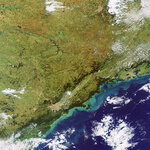Space

Southeastern Brazil, South America’s largest and most populous country, is highlighted in this 26 May 2007 Envisat image.
Brazil consists of one federal district and twenty-six states, four of which comprise the southeastern region – Rio de Janeiro, Minas Gerais, Sao Paolo (all visible) and Espirito Santo.
CLICK ABOVE FOR HIGH RES. Credits: ESA
Rio de Janeiro (located on the coastline on the right side of the image where the water flows inland) is the only state to border all three of the other southeastern states. It is bordered on the East by the Atlantic Ocean, on the South by Sao Paolo,…
Using ESO's VLTI on Cerro Paranal and the VLBA facility operated by NRAO, an international team of astronomers has made what is arguably the most detailed study of the environment of a pulsating red giant star. They performed, for the first time, a series of coordinated observations of three separate layers within the star's tenuous outer envelope: the molecular shell, the dust shell, and the maser shell, leading to significant progress in our understanding of the mechanism of how, before dying, evolved stars lose mass and return it to the interstellar medium.
Sketch of a pulsating red giant…

An international team of astronomers with the Trans-atlantic Exoplanet Survey today announce the discovery of their third planet, TrES-3. The new planet was identified by astronomers looking for transiting planets - that is, planets that pass in front of their home star - using a network of small automated telescopes in Arizona, California, and the Canary Islands. TrES-3 was discovered in the constellation Hercules about 10 degrees west of Vega, the brightest star in the summer skies.
A computer-generated simulation of TrES-3 crossing (transiting) the disk of its host star. TrES-3 transits…
An international team of astronomers led by Ohio State University has examined dark matter in the outer reaches of our galaxy in a new way.
For the first time, they were able to employ triangulation -- a method rooted in ancient Greek geometry -- to estimate the location of dark matter and calculate its mass.
This composite image shows the microlensing event OGLE-2005-SMC-001 as a distant star brightened (left) and dimmed (right) over the summer of 2005, with views taken from two very distant vantage points. The two images in the top row were taken on Earth -- by the 1.3-meter SMARTS…

The latest find from an international planet-hunting team of amateur and professional astronomers is one of the oddest extrasolar planets ever cataloged -- a mammoth orb more than 13 times the mass of Jupiter that orbits its star in less than four days.
Researchers from the U.S.-based XO Project unveiled the planet, XO-3b, at today's American Astronomical Society meeting in Honolulu. Christopher Johns-Krull, a Rice University astronomer and presenter of the team's results, said, "This planet is really quite bizarre. It is also particularly appropriate to be announcing this find here, since…

Evidence for an awesome upheaval in a massive galaxy cluster was discovered in an image made by NASA’s Chandra X-ray Observatory. The origin of a bright arc of ferociously hot gas extending over two million light years requires one of the most energetic events ever detected.
The cluster of galaxies is filled with tenuous gas at 170 million degree Celsius that is bound by the mass equivalent of a quadrillion, or 1,000 trillion, suns. The temperature and mass make this cluster a giant among giants.
“The huge feature detected in the cluster, combined with the high temperature, points to an…

Two merging black holes can generate gravitational waves so powerful that the merged hole shoots out of its host galaxy at a speed of up to 2,500 miles per second, according to a new simulation.
This research, led by Manuela Campanelli at the Rochester Institute of Technology, demonstrates for the first time that the violent recoil that follows a merger is capable of ejecting the supermassive black holes known to lie at the heart of most light-emitting galaxies. These black holes may be cruising through the universe, virtually undetectable unless they should crash into something and gain…

The world's largest and most prolific team of planet hunters announced today (Monday, May 28) the discovery of 28 new planets outside our solar system, increasing to 236 the total number of known exoplanets.
University of California, Berkeley, post-doctoral fellow Jason T. Wright and newly minted Ph.D. John Asher Johnson reported the new exoplanets at a noon media briefing at the semi-annual meeting of the American Astronomical Society (AAS) in Honolulu. The findings are a result of the combined work of the California and Carnegie Planet Search team and the Anglo-Australian Planet Search team…
Using NASA's Far Ultraviolet Spectroscopic Explorer (FUSE) satellite and ground-based telescopes, astronomers have determined, for the first time, the properties of a rare, extremely massive, and young binary star system.
The system, known as LH54-425, is located in the Large Magellanic Cloud, a satellite galaxy of our Milky Way. The binary consists of two O-stars, the most massive and luminous types of stars in the Universe.
An artist depicts the binary system LH54-425, which consists of two very massive stars. The larger star's powerful wind overpowers the smaller star's wind, creating a…
In just a short amount of time, NASA's Spitzer Space Telescope has bagged more than a thousand previously unknown dwarf galaxies in a giant cluster of galaxies.
Despite their diminutive sizes, dwarf galaxies play a crucial role in cosmic evolution. Astronomers think they were the first galaxies to form, and they provided the building blocks for larger galaxies. They are by far the most numerous galaxies in our Universe, and are an important tracer of the large-scale structure of the cosmos. Computer simulations of cosmic evolution suggest that high-density regions of the Universe, such as…